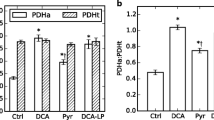Summary
The present study was designed to clarify whether or not a difference between arterial and venous lactate (Δlactate) levels is useful for evaluation of mitochondrial function in ischemia-reperfused myocardium. In the first experiment, 12 dogs were divided into 2 groups: 10-min occlusion of the left anterior descending coronary artery (LAD) followed by 10-min reperfusion, or 30-min occlusion followed by 40-min reperfusion, were performed. The lactate levels in the femoral artery and the great cardiac vein were measured enzymatically. ΔLactate was reversed immediately after occlusion. Ten min and 20 min were required for the recovery of Δlactate in the 10-min-occlusion with 10-min-reperfusion, and 30-min-occlusion with 40-min-reperfusion groups, respectively. In the second experiment, 36 dogs were divided into 6 groups: 10-min occlusion of LAD; 10-min occlusion with 10-min reperfusion; 30-min occlusion; and 30-min occlusion with 10-, 20-, or 40-min reperfusion were performed. Mitochondria from normal and occluded or reperfused areas were prepared, and the respiratory function of the mitochondria was measured polarographically. No significant decreases in the mitochondrial function were observed in the 10-min-occlusion, and 10-min-occlusion with 10-min-reperfusion groups. On the other hand, respiratory function of mitochondria was impaired by 30-min occlusion and was not improved by 10- or 20-min reperfusion. Significant recovery in the mitochondrial function was observed after 40-min reperfusion. That is, differing recovery time courses between Δlactate and the mitochondrial function were observed.
Similar content being viewed by others
References
Bing RJ (1965) Cardiac metabolism. Physiol Rev 45: 171–213
Hearse, DJ (1979) Cellular damage during myocardial ischemia: Metabolic changes leading to enzyme leakage. In: Hearse DJ, deLeiris J (eds) Enzymes in Cardiology: Diagnosis and Research. Wiley, Chichester New York Brisbane Toronto, pp. 1–19
Opie, LH (1980) Myocardial infarct size. Part I. Basic considerations. Am Heart J 100: 355–372
Ichiki T, Tanaka M, Nishikimi M, Suzuki H, Ozawa T, Kobayashi M, Wada Y (1988) Deficiency of subunits of complex I and mitochondrial encephalomyopathy. Ann Neurol 23: 287–294
Opie LH, Owen P, Thomas M, Samson R (1973) Coronary sinus lactate measurements in assessment of myocardial ischemia. Comparision with changes in lactate/pyruvate and beta-hydroxybutyrate/acetoacetate ratios and with release of hydrogen, phosphate and potassium ions from the heart. Am J Cardiol 32: 295–305
Kugler G (1979) Myocardial release of lactate, inosine and hypoxanthine during atrial pacing and exercise-induced angina. Circulation 59: 43–49
Hadjivassiliou AG, Rieder SV (1968) The enzymatic assay of pyruvic and lactic acids: A definitive procedure. Clin Chim Acta 19: 357–361
Hatefi Y, Jurtshuk P, Haavik AG (1961) Studies on the electron transport system. XXXII. Respiratory control in beef heart mitochondria. Arch Biochem Biophys 94: 148–155
Hieda N, Toki Y, Sugiyama S, Ito T, Satake T, Ozawa T (1988) Prostaglandin I2 analogue and propranolol prevent ischaemia induced mitochondrial dysfunction through the stabilisation of lysosomal membranes. Cardiovasc Res 22: 219–225
Parker JO, Chiong MA, West RO, Case RB (1969) Sequential alterations in myocardial lactate metabolism, S-T segments, and left ventricular function during angina induced by atrial pacing. Circulation 40: 113–131
Deuticke B, Beyer E, Forst B (1982) Discrimination of three parallel pathways of lactate transport in the human erythrocyte membrane by inhibitors and kinetic properties. Biochim Biophys Acta 684: 96–110
Taegtmeyer H (1978) Metabolic responses to cardiac hypoxia. Increased production of succinate by rabbit papillary muscles. Circ Res 43: 808–815
Peuhkurinen KJ, Takala TES, Nuutinen EM, Hassinen IE (1983) Tricarboxylic acid cycle metabolites during ischemia in isolated perfused rat heart. Am J Physiol 244: H281-H288
Kitakaze M, Hori M, Tamai J, Iwakura K, Koretsune Y, Kagiya T, Iwai K, Kitabatake A, Inoue M, Kamada T (1987) α1-Adrenoceptor activity regulates release of adenosine from the ischemic myocardium in dogs. Circ Res 60: 631–639
Sugiyama S, Ozawa T, Kato T, Suzuki S (1980) Recovery time course of ventricular vulnerability after coronary reperfusion in relation to mitochondrial function in ischemic myocardium. Am Heart J 100: 829–837
Suzuki S, Kato T, Kambe T, Sakamoto N, Sugiyama S, Ozawa T (1979) An experimental study of release arrhythmia: Occlusion time dependent changes in ventricular fibrillation threshold. Am Heart J 98: 727–731
Hattori R, Takatsu Y, Yui Y, Sakaguchi K, Susawa T, Murakami T, Tamaki S, Kawai C (1985) Lactate metabolism in acute myocardial infarction and its relation to regional ventricular performance. J Am Coll Cardiol 5: 1283–1291
Lang TW, Corday E, Gold H, Meerbaum S, Rubins S, Constantini C, Hirose S, Osher J, Rosen V (1974) Consequences of reperfusion after coronary occlusion. Effects on hemodynamic and regional myocardial metabolic function. Am J Cardiol 33: 69–81
Constantini C, Corday E, Lang TW, Meerbaum S, Brasch J, Kaplan L, Rubins S, Gold H, Osher J (1975) Revascularization after 3 hours of coronary arterial occlusion: Effects on regional cardiac metabolic function and infarct size. Am J Cardiol 36: 368–384
Pavlakis SG, Phillips PC, DiMauro S, De Vivo DC, Rowland LP (1984) Mitochondrial myopathy, encephalopathy, lactic acidosis, and stroke-like episodes: A distinctive clinical syndrome. Ann Neurol 16: 481–488
Author information
Authors and Affiliations
Rights and permissions
About this article
Cite this article
Hanaki, Y., Sugiyama, S., Taki, K. et al. Differing time courses between Δlactate and mitochondrial respiration during coronary occlusion and after reperfusion in canine hearts. Heart Vessels 4, 149–152 (1988). https://doi.org/10.1007/BF02058427
Received:
Revised:
Accepted:
Issue Date:
DOI: https://doi.org/10.1007/BF02058427




